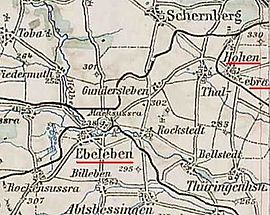Hohenebra-Ebelebener Railway
| Hohenebra – Ebeleben | |||||||||||||||||||||||||||||||||||||||||||||||||||||
|---|---|---|---|---|---|---|---|---|---|---|---|---|---|---|---|---|---|---|---|---|---|---|---|---|---|---|---|---|---|---|---|---|---|---|---|---|---|---|---|---|---|---|---|---|---|---|---|---|---|---|---|---|---|
| Route number (DB) : | 6718 | ||||||||||||||||||||||||||||||||||||||||||||||||||||
| Route length: | 8.7 km | ||||||||||||||||||||||||||||||||||||||||||||||||||||
| Gauge : | 1435 mm ( standard gauge ) | ||||||||||||||||||||||||||||||||||||||||||||||||||||
| Top speed: | 10 km / h | ||||||||||||||||||||||||||||||||||||||||||||||||||||
|
|||||||||||||||||||||||||||||||||||||||||||||||||||||
The Hohenebra-Ebelebener Eisenbahn (HEE) was a railway unit in the Thuringian principality of Schwarzburg-Sondershausen .
history
In the subordinate rule of the Principality of Schwarzburg-Sondershausen, which lies south of the Hainleite ridge , there was initially only one railway line in the 19th century, which was opened in 1869 by the Nordhausen-Erfurt Railway Company. It led from Nordhausen via the residential town of Sondershausen in a southerly direction to Erfurt ( Wolkramshausen – Erfurt railway ).
From the Hohenebra station on this railway line , the state government had the railway company Herrmann Bachstein build a nine-kilometer branch line to the market town of Ebeleben , which had just under 1700 inhabitants, but was the main town of an administrative district in the Helbetal . From the day of the opening, November 20, 1883, the Bachstein company initially ran the railway as a leaseholder. It also became its owner on June 1, 1884, and on February 11, 1895 brought the HEE into the newly founded Süddeutsche Eisenbahn-Gesellschaft (SEG). The management did not change.
Bachstein later combined the railway with the Greußen-Ebeleben-Keulaer Railway in a joint operation with the railway administration in Ebeleben. This existed until 1946, when the state of Thuringia expropriated these private railways and later made them subordinate to the Deutsche Reichsbahn.
On September 28, 1974, passenger traffic from Hohenebra to Ebeleben and on to Schlotheim on the train to Mühlhausen ended. This ended earlier on the Greußen-Ebeleben-Keulaer Railway. Freight traffic on the Ebeleben– Menteroda section to serve the local potash mine and a power station continued until the end of the nineties. Finally, this section of the route, like the one between Ebeleben and Rockensussra , was used to park numerous freight cars that were no longer needed. After these were scrapped in summer 2011, both branches of the route are no longer used.
From Hohenebra to Ebeleben, where a new train station was built elsewhere, the line was renewed in 1974 and is still used for freight traffic today , with wood, gas and grain wagons regularly, sometimes in block trains . The line was initially acquired by the municipal infrastructure company "Ebelebener Netz" mbH and operations were carried out by the railway infrastructure company RbT Regiobahn Thuringia . Since the beginning of June 2011, RbT has also been the owner of the route, which it operates as a public railway infrastructure. Since the installed sleepers by concrete cancer were infested, the route can be traveled only h with 10 km /. In order to be able to maintain the freight traffic, which still takes place several times a week, the damaged sleepers had to be replaced in the following years and the switches in the Ebeleben freight yard had to be renovated.
Web links
- Hohenebra-Ebelebener Eisenbahn on vergessene-bahnen.de
Individual evidence
- ↑ a b See René Krebs, Güterverkehr in Ebeleben, in: Bahn-Report , Heft 6/2011, S. 62, editor: Interest group rail transport eV, Rohr, ISSN 0178-4528
- ↑ Regiobahn Thüringen GmbH: Train path fee list ( Memento from September 17, 2008 in the Internet Archive ), 2007
- ↑ Terms of use of the RbT
- ↑ Hohenebra-Ebeleben railway line gradually renovated. Thüringer Allgemeine, January 25, 2011, accessed January 27, 2011 .

